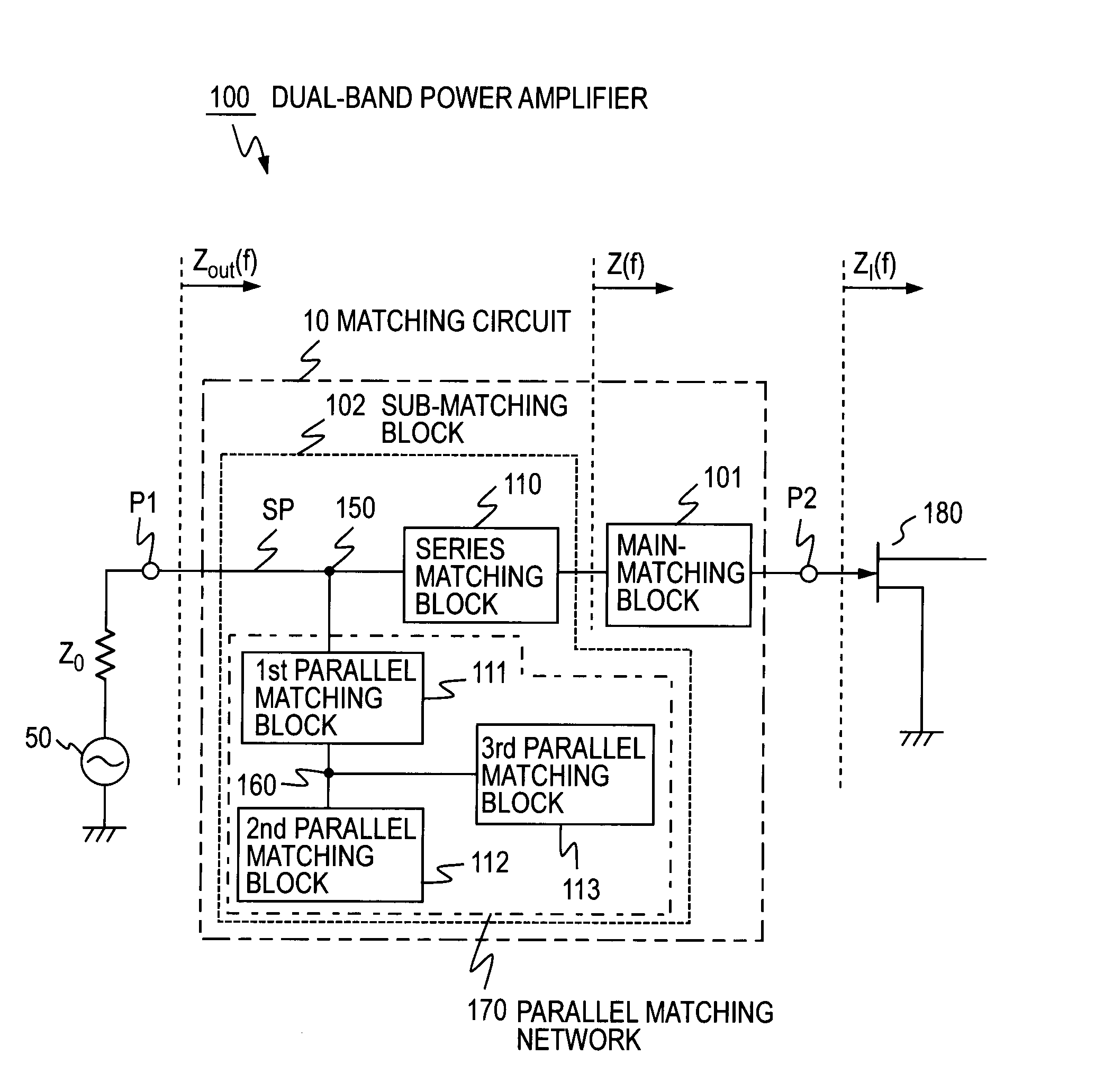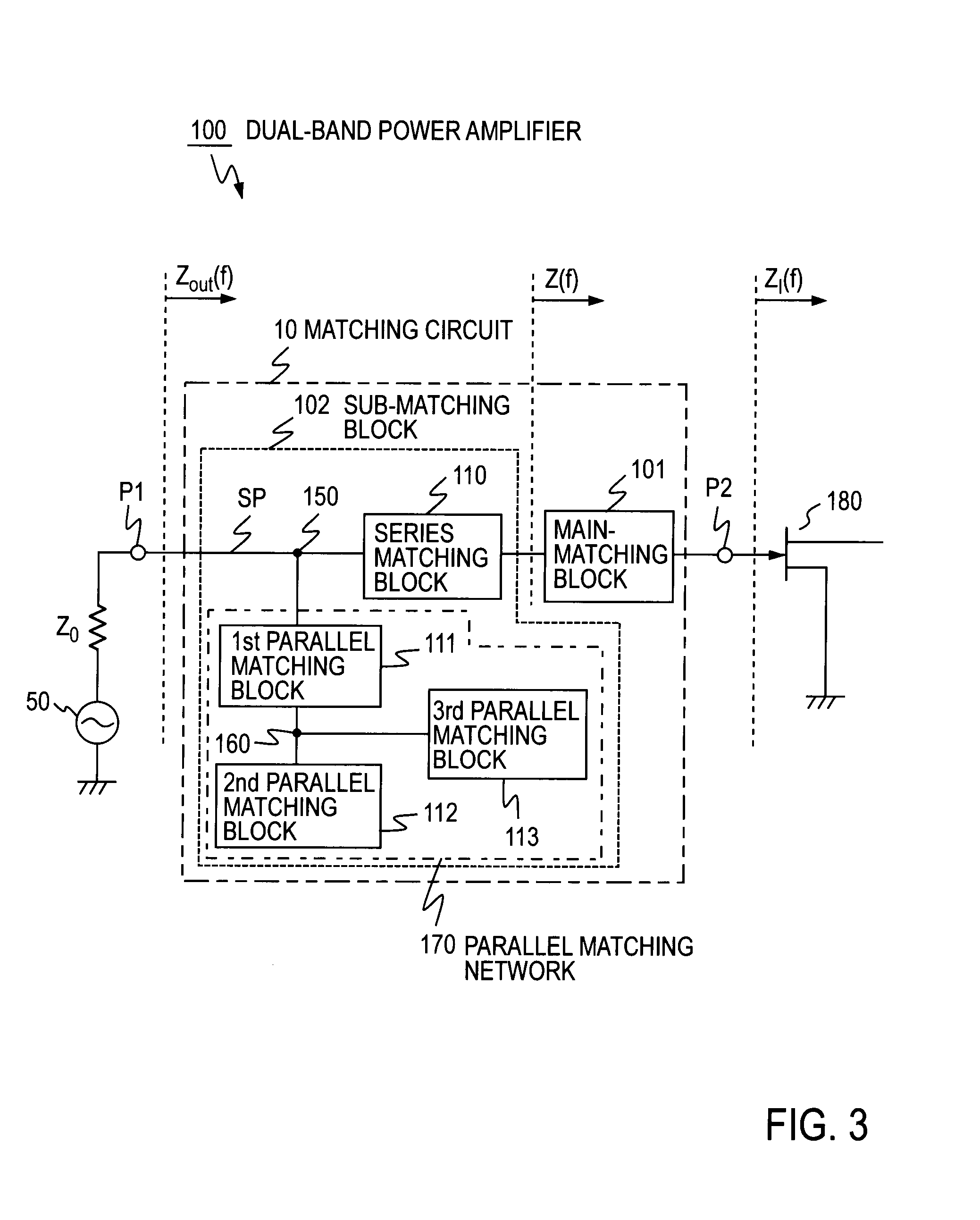Matching circuit and dual-band power amplifier
a matching circuit and power amplifier technology, applied in amplifiers with semiconductor devices/discharge tubes, multi-port networks, transmission, etc., can solve the problems of increasing the size of the device, the difficulty of designing such a circuit that is optimized, and the increase of the number of components such as the input and output matching circuit,
- Summary
- Abstract
- Description
- Claims
- Application Information
AI Technical Summary
Benefits of technology
Problems solved by technology
Method used
Image
Examples
first embodiment
[0042]FIG. 3 illustrates a matching circuit 10 according to the first embodiment. FIG. 3 also illustrates the configuration of an input-side circuit of a dual-band power amplifier 100 which can amplify signals of the two frequency bands of FIG. 14 selectively or simultaneously. The first embodiment is an example where the matching circuit 10 is used on the input terminal side of an amplification device 180. In this context, “can amplify selectively” means that even when either one of the signals of two frequency bands is inputted, it is possible to amplify the signal. “can amplify simultaneously” means that signals of two frequency bands are inputted at the same time, in other words, a combined signal of the two frequency bands can be amplified in the respective frequency bands simultaneously. The same applies to the following description.
[0043]Generally, matching circuits are those for establishing matching between different impedances. An example thereof is to perform impedance ma...
second embodiment
[0067]The first embodiment has exemplarily described the dual-band power amplifier 100 capable of amplifying the signals of the two frequency bands selectively or simultaneously as well as the matching circuit 10 that performs impedance matching on the signals of the two frequency bands selectively or simultaneously. The second embodiment, as an expansion of the first embodiment, will exemplarily describe the dual-band power amplifier 100 capable of amplifying two out of N+1 signals of predetermined frequency bands SB1 to SBN+1, where N assumes an integer of 2 or more, as shown in FIG. 15, as well as the matching circuit 10 that performs impedance matching.
[0068]In the first embodiment previously described, the electric length of the series matching block 110 configured as a transmission line and the reactance value of the third parallel matching block 113 are designed for the second frequency f2 without changing the matching condition at the first frequency f1. The second embodimen...
third embodiment
[0078]The third embodiment, as an expansion of the first embodiment but different from the second embodiment, will exemplarily describe the dual-band power amplifier capable of amplifying two signals out of signals of three or more frequency bands, selectively or simultaneously, as well as the matching circuit that performs impedance matching on signals of two frequency bands, selectively or simultaneously.
[0079]FIG. 11 illustrates the matching circuit 10 according to the third embodiment. FIG. 11 also illustrates the circuit configuration of the dual-band power amplifier 100 capable of amplifying a signal of the first frequency f1 and a signal of another frequency in one of N+1 frequency bands shown in FIG. 15, selectively or simultaneously, where N assumes an integer of 2 or greater. The third embodiment is an example where the matching circuit 10 is used on the input terminal side of the amplification device 180.
[0080]The outline of the matching circuit 10 according to the third ...
PUM
 Login to View More
Login to View More Abstract
Description
Claims
Application Information
 Login to View More
Login to View More - R&D
- Intellectual Property
- Life Sciences
- Materials
- Tech Scout
- Unparalleled Data Quality
- Higher Quality Content
- 60% Fewer Hallucinations
Browse by: Latest US Patents, China's latest patents, Technical Efficacy Thesaurus, Application Domain, Technology Topic, Popular Technical Reports.
© 2025 PatSnap. All rights reserved.Legal|Privacy policy|Modern Slavery Act Transparency Statement|Sitemap|About US| Contact US: help@patsnap.com



